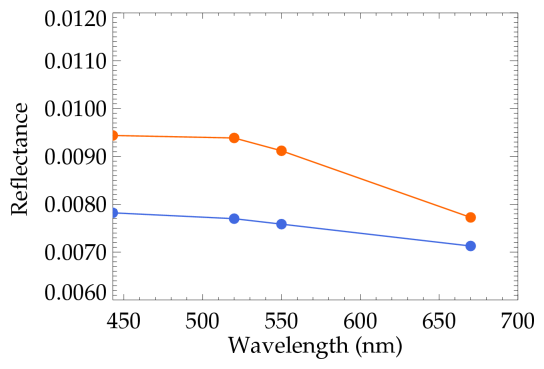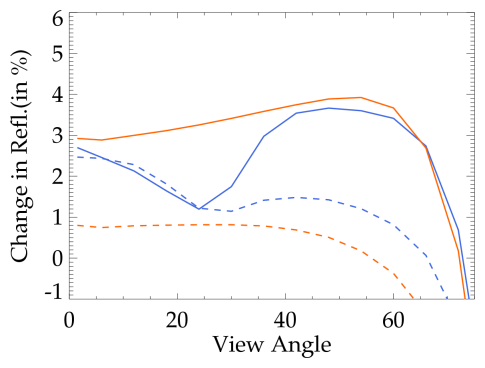The Mexican El-Chichon volcano (17.3N, 95.2W) erupted from 28 March to 4 April 1982 and spewed a large amount of ash and gaseous products into the atmosphere. The large ash particles fell off within a few days, but the gaseous products, particularly, SO2 was converted into sulfuric acid and resided in the stratosphere for a few years [Kruger, 1983]. Airborne lidar data showed that by July 1982 the aerosol cloud had spread up to 30N and by October 1982 the El Chichon cloud boundaries were from 10S to 35N [Bandeen and Fraser, 1982; Robock and Matson, 1983]. Soon after the eruption, the aerosol optical thickness measured at the Mauna Loa Observatory was the largest in the 25-year history of observations [Deluisi et al, 1983, King et al., 1984]. The effect of volcanic eruption was observed in satellite-measurements of geophysical parameters including sea-surface temperature by AVHRR instrument, and ozone measurements by SBUV and TOMS instruments. The sea surface temperature was biased by, as much as 2.5<° C for many months [ Bandeen and Fraser, 1982], and column ozone amount derived with the operational algorithm was much greater than previously observed [Bandeen and Fraser, 1982, Kruger, 1983].
Based on a simulation study, Howard and Castano[1988] had concluded that the El-Chichon aerosols would not have any appreciable effect on the determination of water-leaving radiances from the CZCS instrument. However, recent reprocessing of the CZCS data clearly show significant increase in the retrieved water-leaving radiances in 520 and 550-nm bands during the El-Chichon period. This prompted us to re-examine the effect of El-Chichon aerosols on water-leaving radiances by the CZCS instrument.

As a part of the re-examination, we simulated the top of the atmosphere (TOA) radiances for the CZCS bands with an aerosol layer at 26 km in the stratosphere representing El-Chichon aerosols embodied in a molecular (Rayleigh) atmosphere with a flat ocean as the lower boundary. This height is consistent with the larger eruption on April 4, 1982 [Bandeen and Fraser, 1982]. We used Deirmendjian's[1969] modified gamma distribution to characterize the aerosol size distribution. The parameters of this distribution were determined by DeLuisi et al [1983] by inverting the spectral solar transmission measurements obtained at the Mauna Loa Observatory using King's [1982] constrained linear inversion method. The retrieved size distribution for the month of July 1982 is shown in Figure 2a. We also computed the TOA radiances with the Gordon's M90 aerosol distribution [Gordon and Wang, 1994] that is operationally used to process the CZCS data. M90 is a maritime aerosol model for a relative humidity of 90 percent. It is bi-modal lognormal distribution that is constructed from the Shettle and Fenn's aerosol distributions [1979] for tropospheric and oceanic aerosols. The phase functions in the backward direction for the two distributions are shown in Figure 2b.
Key: Red (M90 aerosol); Green (El Chichon sulphate aerosol)


We simulated the reflectances for all the four bands of the CZCS instrument. Figure 3 shows the spectral dependence of Rayleigh corrected reflectance for the two aerosol models. The results are for Θ0=300, Θ=360, and Φ=960. This sun-view angle geometry corresponds to a scattering angle (Χ) of 1370. From the graph we find that M90 aerosol reflectance increases almost linearly with a decrease in wavelength from 670 to 443-nm. On the other hand, the El-Chichon reflectance increases almost linearly up to 520-nm and then levels off for wavelengths shorter than 520-nm. Also, in the range of 670 to 520-nm, the rate of increase in the reflectance for El-Chichon aerosols is much larger (-1.161x10-5/nm) than for M90 aerosols (-3.806x10-6/nm).

Figure 4 shows the change in the reflectance value when M90 aerosols are replaced by the El Chichon aerosols in the atmosphere. We find that at large solar zenith angle (~60<°) and small view angles (<30<°), the percent change in the reflectance value 443(550) nm is about 0.8(3-3.5) percent. Whereas, for solar zenith angle of ~30 degrees and nadir viewing geometery, the percent change in the 443(550) nm band is ~2.5 (2.8), and the change is about 1.5(3.6) at large view angles (~50<°). We attribute these results to the significant difference in the phase functions of the two aerosol models.

Based on our previous radiative transfer studies, we find that in the oligotrophic waters, one percent change in the TOA radiance is equivalent to about 10 percent change in the water-leaving radiance. Thus, based on the Sun-view angle geometry and aerosol optical thickness, the change in the water-leaving reflectance can vary from 8 to 35 percent. These simulations, contrary to the previously reported results, do show the effect of El-Chichon aerosols on the retrieval of water-leaving radiances observed in the CZCS data.
Bandeen, W. R., R S Fraser, Radiative effects of the El Chichon volcanic eruption, Preliminary results concerning remote sensing, National Aeronautics and Space Administration. Goddard Space Flight Center, Greenbelt, MD, 1982.
DeLuisi, J. J., E. G. Dutton, K. l. Coulson, T. E. DeFoor, and B. G. Mendonca,On some radiative features of the El Chichon volcanic stratospheric dust cloud and a cloud of unknown origin observed at Mauna Loa, J. Geophys. Res., 88, 6769-6772, 1983.
Deirmendjian, D., Electromagnetic Scattering on Spherical Polydispersions, Elsevier, New York, 1969.
Gordon, H. R., D. J. Castano, Coastal zone color scanner atmospheric correction: Influence of El-Chichon, Appl. Opt., 27(16), 3319-3322, 1988.
Gordon, H. R., and M. Wang, Retrieval of water-leaving radiance and aerosol optical thickness over the oceans with SeaWiFS: a preliminary algorithm, Appl. Opt., 443-452, 1094.
King, M. D., Harshvardhan, A. Arking,A model of the radiative properties of the El Chichon stratospheric aerosol layer, Journal of Climate and Applied Meteorology, 23, 1121-1137, 1984.
Krueger, A.J., Sighting of El Chichon sulfur dioxide clouds with the Nimbus 7 total ozone mapping spectrometer, Science, 220: 1377-1379, 1983.
Robock, A., M. Matson, Circumglobal transport of the El Chichon volcanic dust cloud, Science, 221, 195-197, 1983.
Shettle, E. P. and R. W. Fenn, Models for the aerosols of the lower atmosphere and the effects of humidity variations on their optical properties, AFGL-TR-79-0214 (U.S. Air Force Geophysics Laboratory, Hanscomb Air Force Base, Mass., 1979).